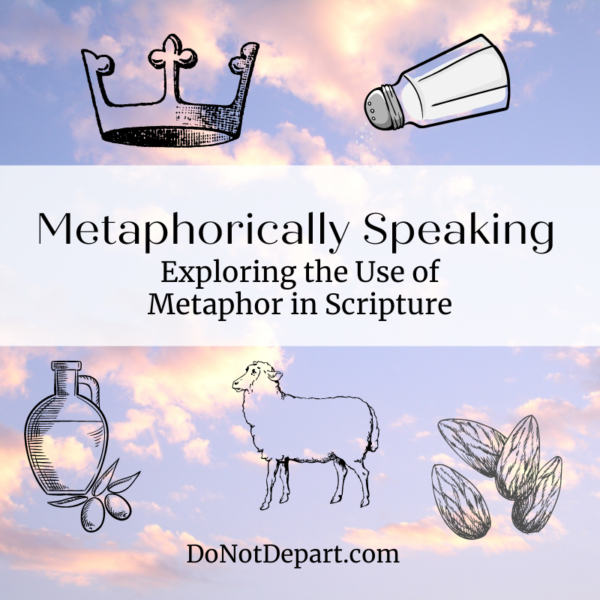
My life is an open book. Love is an open door. When God closes a door, he opens a window. Laughter is music for the soul. All the world is a stage. These are a few of my favorite… metaphors!
As a writer, homeschool mom, and perpetual student of the Bible, I have come to adore language, most especially when it is used to tell our stories. Story is easily the most accessible form of human communication because stories speak first to the heart, engaging the emotions, and then to the mind, inviting participation. Stories reveal the relationship between people and places and things and one very effective, often unassuming tool used to connect people and things in a story is the Metaphor.
Not a Simile but Similar
A metaphor is a figure of speech comparing two things, using something known to explain or describe something unknown (similes are a type of metaphor that use the words as or like in the comparison).
If we were to meet in the grocery store and I tell you my kids are a barrel of monkeys today, thanks to metaphor you’ll know they haven’t literally changed from human to animal, but that their behavior is wild and probably driving me crazy! If I tell you they’re growing like weeds, you’ll know I mean they’re growing quickly. And if you chuckle and remind me that childhood is a candle in the wind, I’ll know you’re reminding me how short and precious these years are.
Metaphors slip easily into our daily conversations and they are an important feature of Scripture too.
“If we don’t understand how metaphor works we will misunderstand most of what we read in the Bible.”
(Eugene Peterson, Eat This Book)
Meta-Poetical
Jesus frequently taught through parables (short stories intended to illustrate wisdom or truth – see some examples here) but he also used metaphors. In the Sermon on the Mount (Matthew 5-7), he calls his disciples salt, light, a lamp, and a city on a hill. He teaches us to be like the sparrows and the lilies and warns against false prophets who are wolves in sheep’s clothing.
Each visual adds to the overall picture, giving us a glimpse of who we are and how we are meant to interact with the world.
He follows a long tradition of Hebrew poets (about 1/3 of the Bible is written in poetry!), using familiar imagery to connect feelings to truth and to give shape to abstract concepts.
The psalmists and the prophets filled their stories and songs with metaphor after metaphor so we can, in some small way, begin to understand the strength and wonder and love of our God. #metaphoricallyspeakingClick To Tweet“For one thing, God’s action and presence among us is so beyond our comprehension that sober description and accurate definition are no longer functional. The levels of reality here are so beyond us that they compel extravagance of language.” (Peterson)
Miraculous Metaphor
When considering the structure of Hebrew poetry, its use of parallelism and metaphor, C.S. Lewis writes, “It is…a wise provision of God’s that poetry which was to be turned into all languages should have as its chief formal characteristic one that does not disappear (as mere meter does) in translation” (Reflections on the Psalms)
Despite thousands of years and miles and the differences in geography and culture that separate us from the world of the ancient authors of Scripture, we modern readers can access the same thoughts and feelings that occupied them through the sharing of common pictures like rocks, eagles, trees, streams, lions, and lambs.
This month on the blog we will be exploring some of our favorite metaphors for and from Scripture and considering together how these images illuminate our understanding of God so we can deepen our relationship with Him.
Thanks for coming on this journey with us! (That’s a metaphor!)

” ‘I have multiplied visions and used similitudes’, says the Lord, ‘by the ministry of the prophets’ (Hosea 12:10)
We need hardly say how striking and appropriate these similitude’s are. There is something in figures that conveys instruction, and presents truth with peculiar power and force to the mind. For one person who can comprehend an argument, there are hundreds who can understand an illustration; and a figure will be stamped on the memory for life, when a proof will be forgotten in ten minutes after it has been clearly laid down. We need not wonder, therefore, that the Lord the Spirit has so filled the Holy Scriptures with figure and illustration; and that the Blessed Lord Himself, who spoke as never man spoke, so opened his mouth in parables, which are, in fact, but extended figures”.